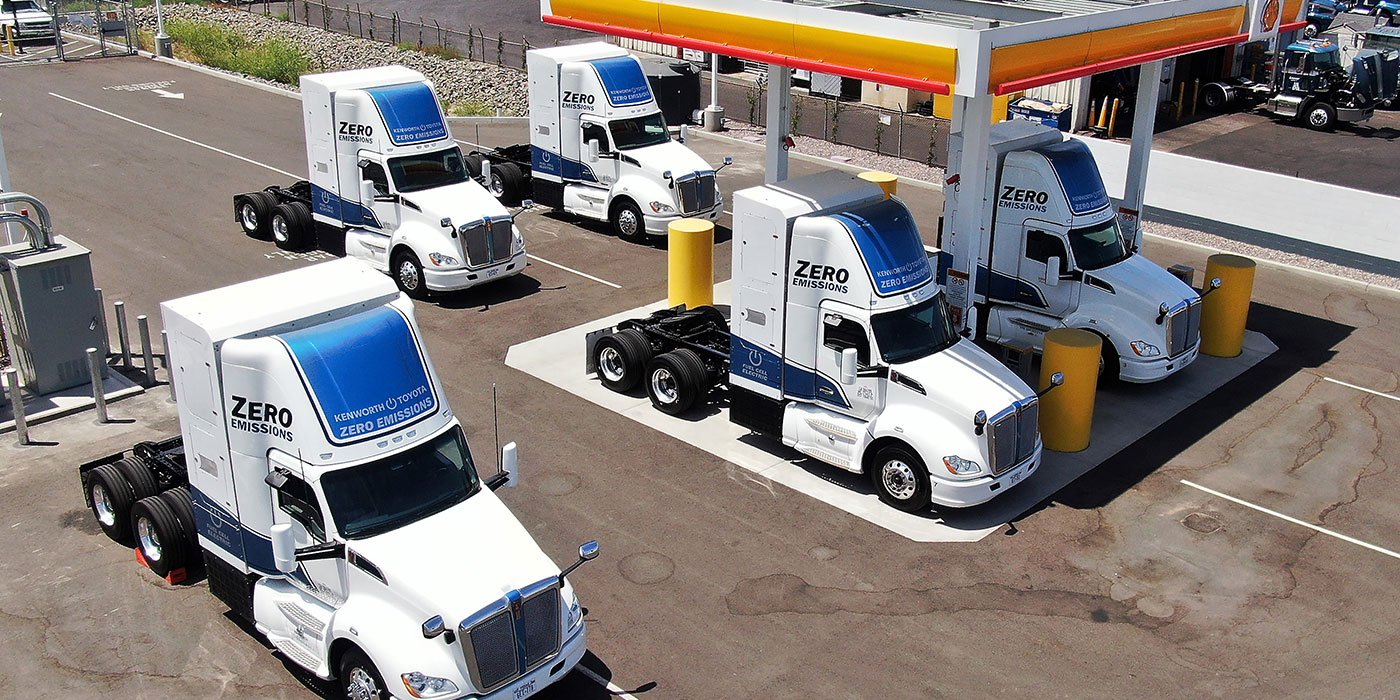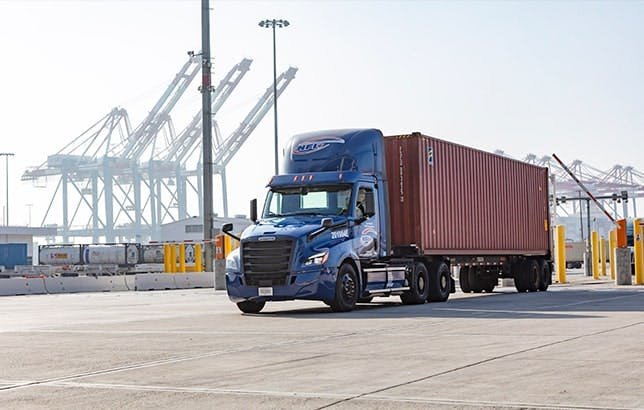
key takeaways for the topic “Electric Trucks Used for Drayage at Port of Los Angeles
1. Sustainable Transportation: The Port of Los Angeles’s use of electric vehicles for drayage operations is a prime example of the expanding movement toward sustainable transportation options. The environmental effect of port-related activities is lessened and air pollution is reduced because electric trucks emit no exhaust emissions.
2. Decarbonizing Port Operations: By substituting cleaner electric trucks for conventional diesel-powered trucks, electric trucks significantly contribute to the decarbonization of port operations. This change is in line with more general sustainability objectives, which include lowering greenhouse gas emissions and enhancing air quality near ports.
3. Better Air Quality: The Port of Los Angeles and the surrounding areas have better air quality because to the use of electric trucks for drayage. Electric trucks contribute to lowering the health hazards associated with pollution for surrounding communities and workers by removing exhaust pollutants such as nitrogen oxides and particulate matter.
4. Noise Reduction: Compared to diesel trucks, electric trucks run noticeably quieter, which reduces noise pollution in port regions. This benefit lessens disruptions for surrounding residents while also enhancing the general working environment for port employees.
5. Technological developments: The developments in electric vehicle (EV) technology, such as enhanced battery capacity and charging infrastructure, are reflected in the use of electric trucks for drayage. Electric trucks are becoming a feasible and useful choice for heavy-duty transportation requirements, like port operations, thanks to these improvements.
6. Public-Private Collaboration: Public agencies, private businesses, and stakeholders frequently work together to deploy electric trucks for drayage in the Port of Los Angeles. This collaborative strategy encourages investment, innovation, and shared accountability in promoting the uptake of environmentally friendly transportation options.
7. Economic Benefits: In addition to their environmental advantages, electric trucks may also have economic benefits. In the long run, they can result in cheaper operating costs, such as decreased fuel and maintenance expenditures. In addition, as the market for electric vehicles expands, so do the chances for employment development and economic expansion within the sector.
8. Scalability and Replicability: The Port of Los Angeles’s effective use of electric vehicles for drayage provides a model that may be expanded upon and copied in other port operations across the world. It illustrates the viability and possible advantages of switching to electric vehicles for the movement of cargo in different port environments.
9. Policy Support: Using electric trucks for drayage is in line with government programs and regulations that support environmentally friendly transportation and fight global warming. The use of electric trucks in port operations can be further accelerated by supportive policies including financial incentives and rules that encourage the switch to zero-emission vehicles.
The significance of sustainable transportation, decarbonization efforts, improved air quality, noise reduction, technological advancements, public-private collaboration, economic benefits, scalability and replicability, and policy support are highlighted by these key takeaways, which also highlight the adoption of electric trucks for drayage at the Port of Los Angeles.

Benefits of Electric Trucks for Drayage
The Port of Los Angeles’ drayage operations can profit greatly from the use of electric trucks.
Their lower environmental impact when compared to conventional diesel trucks is one of their main advantages. Since electric trucks emit no pollutants, the neighboring towns enjoy healthier conditions and cleaner air.
Furthermore, compared to diesel vehicles, electric trucks are quieter, which reduces local noise pollution.
The cheaper running costs of electric trucks are an additional advantage. Electric vehicles require less fuel and maintenance than diesel trucks, even if their initial cost may be more.
Additionally, electric vehicles can help create a more sustainable transportation system by lowering reliance on fossil fuels.
Overall, there are several advantages to using electric vehicles for drayage in the Port of Los Angeles, such as decreased operating costs, emissions, and a more sustainable future.
Implementation of Electric Trucks at Port of Los Angeles
At the Port of Los Angeles, the introduction of electric trucks has happened gradually.
The requirement for an adequate infrastructure for charging electric trucks was one of the primary implementation issues. The port has been making efforts to increase the capacity of its infrastructure for charging electric trucks.
The requirement for truck drivers and operators to receive education and training was another facet of the implementation process. Switching from diesel to electric trucks necessitates a distinct set of abilities.
Additionally, the port has worked with tech firms and truck manufacturers to create and test electric truck models appropriate for drayage operations.
In general, the Port of Los Angeles’s deployment of electric trucks has required resolving infrastructure-related issues, offering instruction and training, and collaborating with business partners to create appropriate electric truck models.
Environmental Impact and Sustainability
At the Port of Los Angeles, using electric trucks for drayage has a major positive environmental impact and promotes sustainability.
Through the installation of electric trucks in lieu of diesel ones, the port may lower greenhouse gas emissions and enhance the quality of the air in the nearby neighborhoods.
Since electric trucks have no tailpipe emissions, the port’s operations have a lower overall carbon impact.
Furthermore, the port’s commitment to minimizing its environmental impact and sustainability goals are in line with the use of electric trucks. The switch to electric trucks is in line with larger international initiatives to reduce greenhouse gas emissions and move toward a low-carbon economy. In general, the Port of Los Angeles’s usage of electric trucks for drayage is essential to lowering emissions and advancing sustainability.
Challenges and Future Outlook
Even though the Port of Los Angeles has benefited from the introduction of electric trucks, there have been certain difficulties.
The short battery life and restricted range of electric trucks is one of the primary issues. Long-distance truck travel is necessary for drayage activities at the port, and present battery technology might not be able to meet these demands.
The availability of infrastructure for charging is another difficulty. Although the port has been making efforts to increase the infrastructure for charging, more charging stations are still required to accommodate the increasing number of electric trucks.
Another issue with electric trucks is their expense. Compared to diesel trucks, electric vehicles have greater initial expenses of acquisition but have lower running costs. For truck drivers who are thinking about switching to electric trucks, this can be a barrier.
The future of electric vehicles at the Port of Los Angeles looks bright despite these obstacles. It is anticipated that the existing constraints will be addressed by developments in battery technology and the ongoing growth of the charging infrastructure.
Additionally, truck owners and the port find electric trucks to be a desirable alternative due to their possible cost savings and environmental advantages.
In conclusion, even though there are obstacles to be solved, the Port of Los Angeles’s use of electric vehicles for drayage appears to have a bright future. have the potential to become the industry standard.
Conclusion
At the Port of Los Angeles, the use of electric vehicles for drayage is a big step in the direction of a greener and more sustainable transportation system.
Many advantages come with electric trucks, including lower operating costs, fewer emissions, and quieter operation.
The port’s deployment of electric trucks has required working with industry partners, fixing infrastructure issues, and offering instruction and training.
Electric trucks have a big environmental impact since they help the local communities’ air quality and reduce greenhouse gas emissions.
The future of electric vehicles at the Port of Los Angeles is bright, despite obstacles including restricted range, short battery life, and higher starting prices. These issues should be resolved by improvements in infrastructure and technology.
In conclusion, the Port of Los Angeles’s usage of electric vehicles for drayage is a development that is good and helps to create a transportation system that is more efficient and sustainable.
FAQ
What electric trucks are in the Port of Los Angeles?
At the moment, the Port of Los Angeles is using a number of electric truck models for drayage operations. These consist of well-known types such the BYD electric trucks, Volvo electric trucks, and Tesla Semi. Every one of these models has certain qualities and advantages that add to the overall sustainability and effectiveness of port operations. The Port of Los Angeles is projected to further consolidate its commitment to a cleaner and greener transportation system in the near future as more electric truck models enter its fleet due to developments in electric vehicle technology.
How many Drayage trucks are in California?
In California, there are about 30,000 drayage trucks in operation as of the latest available data. The state’s thriving logistics sector depends on these vehicles for the efficient transportation of commodities to and from ports, warehouses, and distribution centers. The switch to electric drayage trucks is becoming more common in California, especially at large ports like the Port of Los Angeles, as attention on sustainability and environmental effect grows. This move to electric trucks is consistent with the state’s goal of having a greener transportation system in addition to lowering emissions and improving air quality.
What is a drayage truck?
Drayage trucks, sometimes referred to as dray trucks, are automobiles made especially for transporting cargo and goods over short distances. These vehicles are essential for moving freight and containers from ports to surrounding train yards, warehouses, and distribution hubs. For the logistics sector, drayage trucks are vital because they make it easier to move cargo between trucks, trains, and ships.
Generally speaking, drayage trucks have qualities like strong chassis, strong engines, and lots of cargo space that make them ideal for the job at hand. They make several trips a day to move items fast and efficiently, and they are frequently utilized for local or regional deliveries.
A greater focus has been placed in recent years on switching drayage trucks to electric models in order to lower emissions and enhance the quality of the air in port areas. In line with the industry’s drive for more environmentally friendly transportation options, electric drayage trucks provide a more sustainable and clean alternative to typical diesel trucks. The adoption of electric drayage trucks is anticipated to develop in tandem with the growing demand for environmentally friendly drayage choices, hence augmenting the sustainability of transportation operations at ports such as the Port of Los Angeles.
Which trucks are used for ports?
Port trucks are essential for the effective movement of cargo to and from ports, warehouses, and distribution centers, particularly when it comes to drayage activities. The special requirements of port logistics, such as the short-distance transportation of freight and containers, are catered for in these trucks’ design. Port trucks, with their robust chassis, strong engines, and large cargo capacities, are indispensable for enabling the smooth and efficient transition of commodities between various means of transportation.
In recent years, there has been a growing emphasis on switching port trucks to electric models to reduce emissions and improve air quality in port areas. In keeping with the industry’s drive for more environmentally friendly transportation options, electric port trucks provide a more sustainable and clean alternative to conventional diesel trucks. Electric port trucks are predicted to become increasingly common as ports like the Port of Los Angeles continue to place a high priority on environmental stewardship and sustainability, which will help to make port operations even more efficient and environmentally friendly.
I hope this article was helpful for more check out our previous blogpost by clinking here

